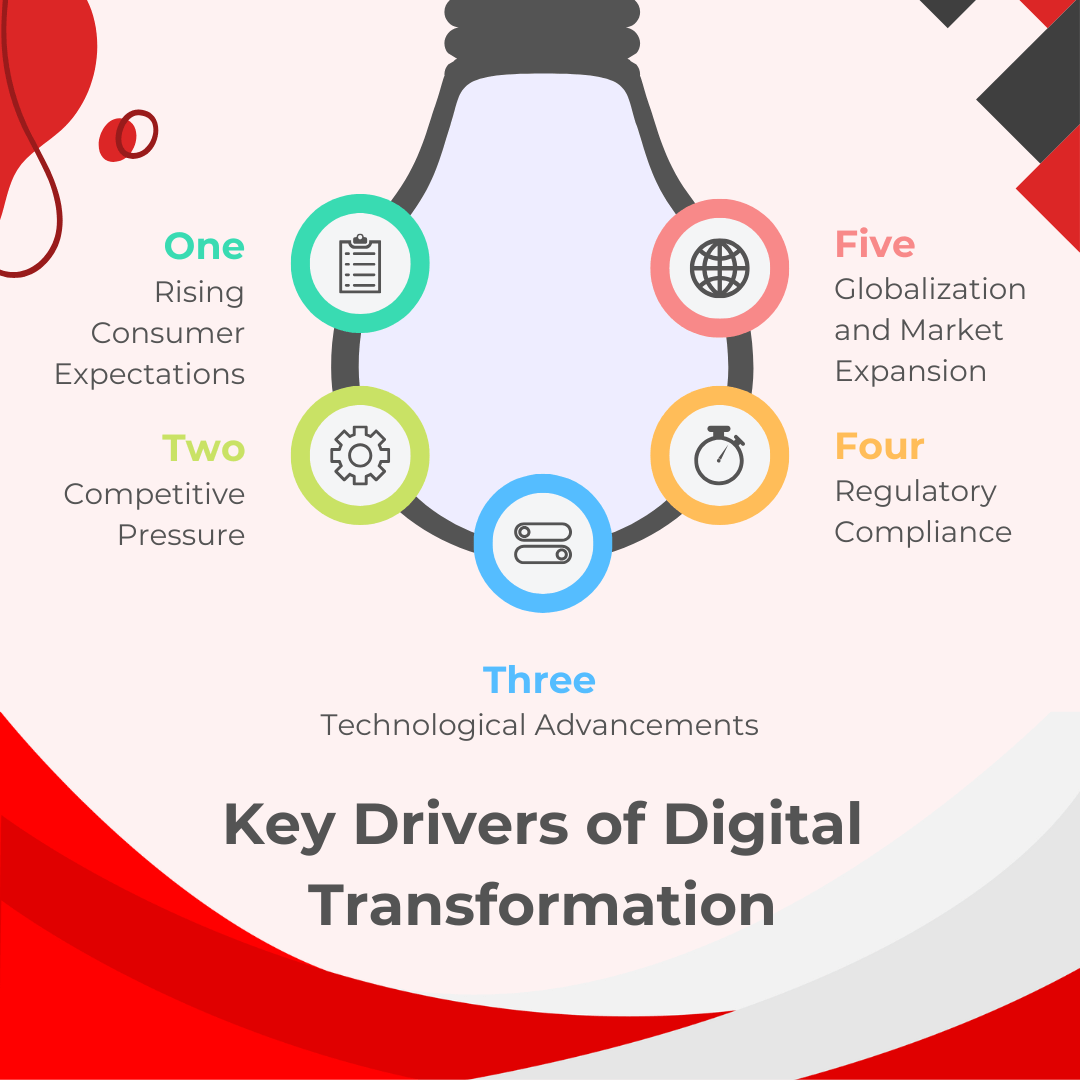Introduction
In today’s fast-paced business landscape, companies struggling to keep up with technological advancements face declining efficiency, rising costs, and loss of market relevance. The pressure to adapt is overwhelming, with outdated systems and processes stalling growth and innovation.
Digital transformation offers a solution by modernizing operations, enhancing customer experiences, and driving competitive advantage. Embracing this transformation is imperative for success in the digital age.
Key Drivers of Digital Transformation
Digital transformation is no longer a buzzword—it's a critical strategy for businesses aiming to stay competitive in today’s rapidly evolving market. Several key drivers are propelling organizations to embrace this change:
- Rising Consumer Expectations: Modern consumers demand personalized, seamless experiences across platforms, pushing businesses to adopt digital technologies or risk losing customers.
- Competitive Pressure: Saturated markets compel companies to innovate and streamline operations through digital transformation, gaining a competitive edge.
- Technological Advancements: Rapid innovations in AI, cloud computing, and IoT offer opportunities for process optimization, cost reduction, and productivity enhancement.
- Regulatory Compliance: Stricter regulations on data protection and transparency drive digital transformation, enabling businesses to comply and turn compliance into a competitive advantage.
- Globalization and Market Expansion: Digital transformation allows businesses to adapt quickly to new markets, manage global teams, and scale operations efficiently.

Core Technologies Enabling Digital Transformation
Digital transformation is driven by key technologies that modernize operations and create new opportunities:
- Cloud Computing: Offers scalable, flexible infrastructure, enabling faster deployment of applications and reducing reliance on physical hardware.
- Artificial Intelligence (AI) and Machine Learning (ML): Enhance data analysis, automate processes, and personalize customer experiences, leading to smarter decision-making.
- Big Data and Analytics: Enable deep insights into customer behavior and market trends, driving informed decisions and innovation.
- Internet of Things (IoT): Connects physical devices to the digital world, improving efficiency and enabling real-time monitoring and control.
- Blockchain: Provides secure, transparent transaction records and data sharing, with applications in supply chain management and digital identity verification.
- 5G and Edge Computing: Transform connectivity and data processing, enabling low-latency applications and real-time analytics for advanced industries.
Strategic Framework
A successful digital transformation requires a well-defined strategic framework. This framework ensures that organizations can effectively integrate new technologies and achieve their goals. Here’s a quick summary of the essential components:
- Assessment and Planning: Evaluate your current technology, identify gaps, and conduct a SWOT (Strengths, Weaknesses, Opportunities, Threats) analysis. Set measurable goals aligned with business objectives and prioritize projects. Create a roadmap with key milestones and resource needs.
- Implementation: Manage projects with a cross-functional team. Establish timelines, allocate resources, and use agile practices for flexibility. Regularly update stakeholders to address concerns.
- Optimization and Scaling: After implementation, optimize processes and scale solutions. Monitor KPIs, refine strategies with data analytics, and ensure technologies are fully integrated and adopted.
Industry Applications of Digital Transformation
Digital transformation is reshaping industries by enhancing efficiency, customer experience, and innovation. Here’s a snapshot of how it’s being applied across key sectors:
- Healthcare: Improves patient care through Electronic Health Records (EHRs) and telemedicine, while data analytics and remote monitoring enhance treatment and patient engagement.
- Finance: Innovates banking with digital platforms, AI-driven fraud detection, and blockchain for secure transactions, ensuring compliance with evolving regulations.
- Retail: Enhances customer experience through omnichannel strategies and personalized marketing, while automation and data analytics optimize operations and supply chains.
- Manufacturing: Introduces smart factories with IoT, predictive maintenance, and robotics, improving efficiency, reducing downtime, and enabling precise operations with digital twins.
Challenges
Digital transformation brings substantial benefits, but it also presents several challenges that organizations must navigate:
- Cybersecurity Risks: New technologies increase vulnerability to cyber threats. Strong security protocols, regular updates, and employee training are essential to protect sensitive data.
- Data Privacy Concerns: Adhering to regulations such as GDPR and CCPA is essential. Implementing robust data governance and maintaining transparency are key to meeting these requirements.
- Resistance to Change: Organizational resistance can impede transformation. Effective change management, clear communication, and early engagement can help ease transitions.
- Integration Challenges: Merging new technologies with existing systems can be challenging. A thorough tech assessment, choosing compatible solutions, and phased implementation are vital for smooth integration.
Key Takeaways
- Digital Transformation Definition: Integrates advanced technologies to enhance business operations and customer experiences.
- Core Technologies: Cloud computing, AI, IoT, Big Data, and Blockchain are crucial for driving transformation.
- Strategic Framework: Assess current tech, set clear goals, and implement and optimize with a focus on scalability.
- Industry Applications: Significant impacts are seen in healthcare, finance, retail, and manufacturing, improving efficiency and innovation.
- Future Trends: Quantum computing, edge computing, 5G, and AI-driven automation will shape the next phase of digital transformation.
Conclusion
Digital transformation is vital for staying competitive, leveraging technologies like cloud computing, AI, IoT, Big Data, and blockchain to enhance efficiency and customer experiences.
To succeed, organizations need a strategic framework: assess current tech, set goals, implement changes, and focus on optimization while managing cybersecurity, data privacy, and resistance.
Emerging trends such as quantum computing, edge computing, and 5G will further impact business operations. By navigating these changes proactively, businesses can secure a competitive edge and drive long-term success.

